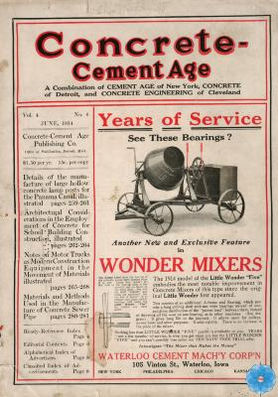Concrete Pioneer
Charles Macdonald spent most of his twenties and thirties as a wanderer. Several years at sea were followed by several years in British Columbia. Only in 1912, at the age of 38, was Macdonald ready to come home to Nova Scotia and to settle down. He would devote the next forty years of his life to manufacturing, promoting, and using concrete.
Concrete had been used on a large scale since the 1850s, and on a small scale since the heyday of the Roman Empire, but it still seemed like a new and unusual material in 1912. Certainly the residents of Centreville (just north of Steam Mill) made fun of Macdonald when he started his cement brick factory on Saxon Street. The concrete business cannot have been terribly lucrative at first, for Macdonald was driven to live in a tent outside his factory. Before long, though, World War One created a market for concrete - an important war material. In 1916, Macdonald got married. Mabel Misner of Chipman Brook helped her husband turn the erstwhile factory into a house.
And what a house it is. Macdonald built something that stands apart from just about anything else in the province. Not only did he build his home entirely from reinforced concrete, but he built in his own style, a style influenced by the buildings he had seen as a sailor in South America and the Mediterranean, as well as by his own eccentricity and sense of humour. Sunshine yellow paint, concrete stucco, tree-shaped columns, and flat roofs come from Santos, Malta, and Naples. The concrete bath-tub, the handprints on the concrete window-sill, and concrete animals on the lawn could only have come from Charlie.
With his Centreville factory now his house, Macdonald opened a new plant in Yoho, just outside Kings County's shire town of Kentville, and conveniently close to a gravel pit. Kentville Concrete Products made their own concrete into a wide range of pre-cast products - pipe, blocks, well curbs, septic tanks, lawn furniture, and more. All of this from a firm of less than a dozen employees.
Kentville Concrete Products is just as notable for the way it was run as for what it made. When Charlie lived in Vancouver, he joined the Socialist Party of Canada and became a trenchant critic of capitalism. Accordingly, he decided that his company would operate to benefit his workers rather than to make him rich. The company ran cooperatively. Workers at Kentville Concrete did not receive wages, but "drew what they needed" from company coffers. Charlie believed in social progress and the company embodied it. Even company advertising promoted concrete as only one part of a vast movement of social change.
The Great Depression of the 1930s did not spare the Annapolis Valley, and the men of Kentville Concrete Products soon found themselves without paying customers. Charlie had been foresighted enough in the good times of the 1920s to sock away a little money "for a rainy day," so the company did not have to let anyone go. Instead, they embarked on a great building project.
Charlie and his wife Mabel had gone camping every summer since 1919 at Huntington Point, just west of the fishing village of Hall's Harbour. The windswept seaside locale had made a great impression on Charlie. It occurred to him that other people might enjoy it too. With that thought in mind, and with the depression of the 1930s halting other projects, Charlie and Kentville Concrete Products built five concrete cottages at the Point between 1934 and 1938.
Built of concrete reinforced by iron and driftwood, brightly painted, and infused with a whimsical sensibility, the secluded cottages have charmed countless visitors who have stumbled upon them. A Christian Science Monitor correspondent had it right in 1941 when she declared that the cottages were the sort of houses "in which Snow White and her seven dwarfs might have lived".
The seven dwarfs really did not live there, of course. Charlie and Mabel took one cottage for themselves, and the others were rented very cheaply until Charlie met prospective buyers whom he trusted to care for them properly. Four of the cottages survive today: the Green Cottage, the Log Cottage, the Blue Cottage and the Macdonald Cottage. The fifth, called the "Teapot Cottage," was destroyed in 1982.
Charlie oversaw the day-to-day operations of Kentville Concrete Products until one day in 1951 when he walked up to the foreman at quitting time, handed over the keys to the plant, and proclaimed, "It's yours!" He was 77 years old. While Charlie would keep up his association with Kentville Concrete, he would enjoy a long and comfortable retirement - much of it spent at Huntington Point.








